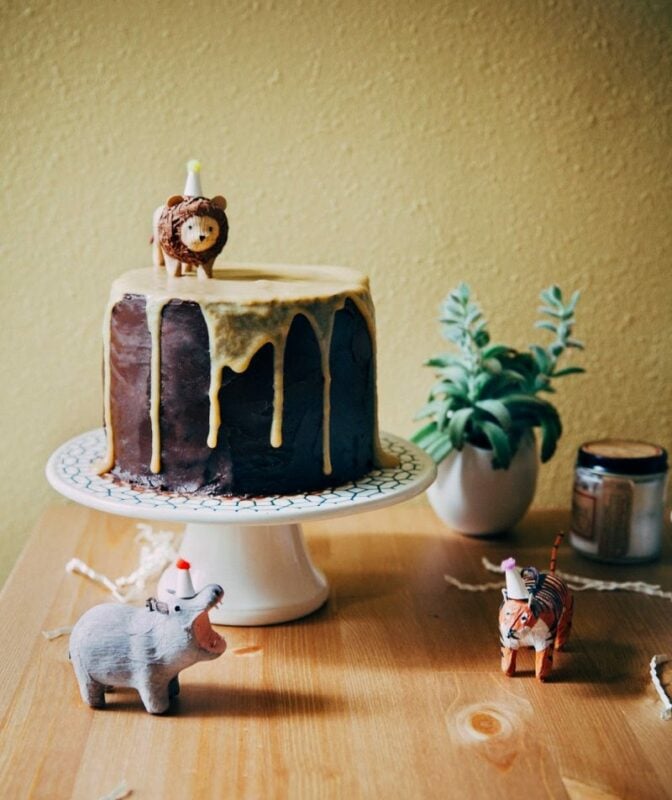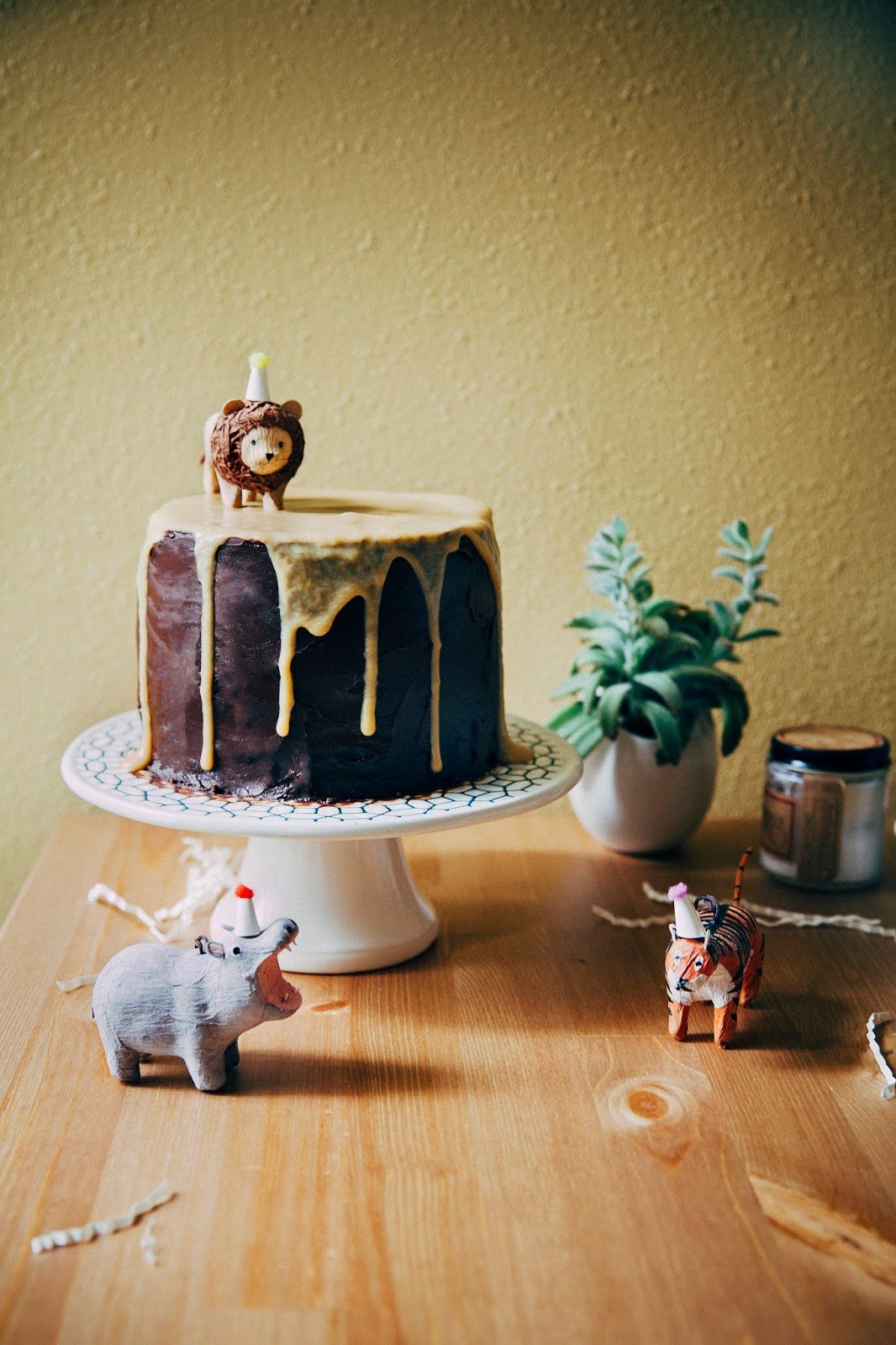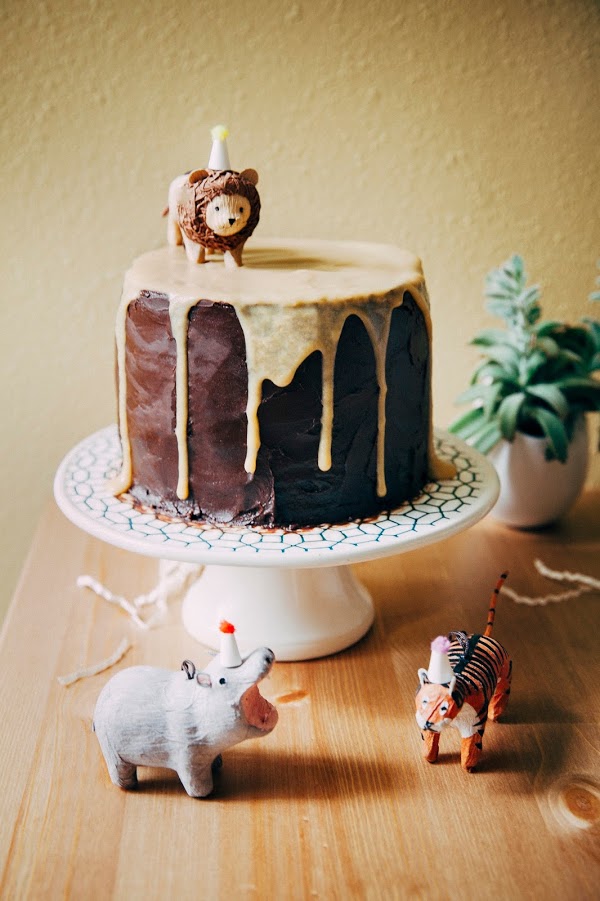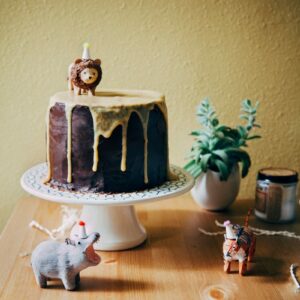Guys, I’m 28 today.
I don’t have too many feels about it, except that, according to this Buzzfeed article, it’s supposed to be the best year of my twenties. I don’t know about that, but I do know that I have a reservation at one of my favorite restaurants in San Francisco, a new creme brûlée torch courtesy of the boyf (since I woefully gave mine away when I left Portland), and the BEST yellow birthday cake recipe to celebrate:
Because if you’ve been a reader of my blog for sometime, you’ll know that I’m a firm believer in the fact that birthdays should be celebrated with a yellow cake covered in generous amounts of dark chocolate frosting. I made one for Erlend’s birthday a few years ago, and I made myself this saffron butter cake with cardamom and milk chocolate fudge frosting last year.
I’m cheating a little bit with this year since this is actually the same recipe I made for Erlend with some slight variations. The original recipe is one of my favorites and comes from Miette, one of my favorite bakeries in San Francisco. Its a decadent butter cake that uses TEN egg yolks (and no egg whites!) to give the cake its sunny yellow color; the cake is then soaked with a simple syrup to keep it ever so moist.
So what did I do to a cake recipe that I love so much to make it even better? One word: BOOZE. Lots of it. Since I love the flavor combination of chocolate orange, I soaked the cake with a Grand Marnier syrup and added some orange zest to the yellow cake batter. The boozy orange paired wonderfully with the dark chocolate ganache frosting.
And because it was my birthday, I figured I’d be extra freaking decadent and top the cake off with a caramelized white chocolate ganache. Did you know that if you roast white chocolate at a low temperature for about an hour or so (but more on this later, in the baker’s notes — don’t panic just yet!), it caramelizes and you get the most wonderful toasted white chocolate flavor? The end result is almost like a dulce de leche caramel and it’s absolutely heavenly.
Some baker’s notes:
- There’s a lot going on with this cake, so I suggest breaking it down by making the cake first, and then the syrup two ganaches the following day. Make the cake first and cover it in plastic wrap and keep it in the refrigerator until you’re ready to frost it — the cake’s butter flavor actually intensifies overnight.
- So, this cake uses a shit-ton of egg yolks. You will need to use an entire dozen’s total for the cake and the frosting combined. I recognize the ridiculousness of that situation (but it was my birthday, and I had to indulge myself), so let me offer you up these recipes for the leftover eggwhites: use 4 egg whites for this rhubarb and pistachio pavlova, another 4 egg whites for this white chocolate malt cake, and the rest for an egg white scramble with a ton of spinach, fresh herbs, and gruyere.
- Let’s talk more about caramelized white chocolate, because I know I just dropped it in there last minute like whoa. I first found out about the phenomenon ever since spying this recipe in Food52’s Genius Recipes cookbook and I’ve been playing around with it since. My one complaint, however, is that the original recipe requires you to heat at a ridiculously low temperature (265 (F)) for almost an hour, along with stirring it every three minutes or so. It’s fussy, because if the chocolate gets too hot, it seizes and turns into solid crumbles instead of caramelizing.So a couple of things: because the oven in my new apartment runs so insanely hot and I really don’t have time to stir something in the oven every 3 minutes, I started playing around with trying to find a shortcut. I found out that you can basically get the same result in almost a quarter of the time suggested by the original recipe if, instead of baking in an oven, you cook the white chocolate over the stovetop. The trick is to melt the white chocolate over low heat, and then once it’s melted completely, turn the heat on high and to scorch it. Stirring constantly to distribute the heat evenly throughout the mixture achieves the same sort of caramelization, and I found that I actually had more control over the final flavor using the stovetop method — because it’s happening right in front of you, you can really control how roasted and caramelized you want the final product to be.
- It took me a couple of times to get the ratio of white chocolate to cream for the topping; don’t be afraid to troubleshoot it! If you find the ganache to be too runny, feel free to add a few more chunks of white chocolate to thicken it up. If it’s too thick, add a splash of cream. The trick is to add just a little bit at a time to get the consistency you want. Because you’re going to be pouring it over the cake, you’re going to want a ganache that’s still warm and just ever-so-slightly runnier than normal to get that pretty spilled frosting look. The ganache will set as it cools.
Get the Recipe: Boozy Yellow Birthday Cake with Chocolate Frosting and Caramelized White Chocolate Ganache
Ingredients
For the Yellow Birthday Cake
- 1 cup granulated sugar
- zest from 1 large orange
- 1 2/3 cups all-purpose flour
- 2 teaspoons baking powder
- 1 teaspoon kosher salt
- 3/4 cup plus 2 tablespoons (1 1/2 sticks plus 2 tablespoons) unsalted butter, at room temperature
- 10 large egg yolks, at room temperature
- 2/3 cup buttermilk
- 1/2 teaspoon pure vanilla extract
For the Grand Marnier Simple Syrup
(makes around 1/4 cup)
- 1/4 cup granulated sugar
- 2 tablespoons water
- 2 tablespoons Grand Marnier, divided in half
- pinch of fresh orange zest
For the Chocolate Ganache Frosting
(makes around 3 cups)
- 10 ounces 70%-cacao dark chocolate, roughly chopped
- 2/3 cup confectioners' sugar, sifted
- 3/4 cup plus 1 tablespoon heavy cream
- 2 large egg yolks
- 3 tablespoons unsalted butter, at room temperature
For the Caramelized White Chocolate Ganache
(makes around 1/3 cup)
- 4 ounces white chocolate, finely chopped
- 1/4 cup heavy cream
- a pinch of kosher salt
Instructions
For the Yellow Birthday Cake
- Center a rack in the oven and preheat to 350 (F). Prepare 3 six-inch cake pans by liberally spraying with cooking spray and lining the bottom of each pan with a parchment paper circle. Spray the parchment paper as well, and set aside.
- In a small bowl, combine 1 cup granulated sugar and the fresh zest from 1 large orange. Use your fingers to rub the zest into the sugar, incorporating it throughout the bowl to mix the two together. As you rub the zest into the sugar, your sugar should become fragrant as you’re helping release oils from the zest. Set aside when the two are well combined.
- In a medium bowl, whisk together 1 2/3 cups all-purpose flour, 2 teaspoons baking powder, and 1 teaspoon kosher salt. Set aside.
- In the bowl of a freestanding electric mixer fitted with a paddle attachment, combine 3/4 cup plus 2 tablespoons unsalted butter and the orange-infused sugar (from the 2nd step). Beat on medium speed until light colored and fluffy, at least 10 to 12 minutes. Add 10 large egg yolks in 3 additions, beating until completely combined after each, about 2 minutes per addition, and stopping to scrape down the sides of the bowl with a rubber spatula before adding more yolks. Once the yolks have all been added, increase the mixer speed to its highest setting and beat for another 30 seconds to fully combine, before turning the mixer off completely. Use a rubber spatula to scrape down the sides of the bowl.
- In a liquid measuring cup, whisk together 2/3 cup buttermilk and 1/2 teaspoon pure vanilla extract. Set aside.
- Turn the mixer back on to its lowest setting. With the mixer on low speed, add the dry ingredients (from the 3rd step) in 3 additions alternating with the buttermilk mixture (from the the 5th step) in 2 additions, beginning and ending with the dry ingredients. After each addition, beat until just combined, being careful not to overmix. It’s best to stop the mixture early with one or two flour streaks left, and finish the rest by hand by scraping down the bowl and folding the mixture one or two more times.
- Use a cookie dough scoop to divide the batter evenly between the prepared pans, using an offset spatula to smoothen the tops. Bake in the preheated oven for around 35 to 40 minutes, or until the cakes are lightly brown and a skewer inserted in the center of each cake comes out clean
- Transfer the cakes to wire racks and let cool for about 20 minutes, before turning out onto the wire racks to cool completely.
For the Grand Marnier Simple Syrup
- In a small saucepan, combine 1/4 cup granulated sugar, 2 tablespoons water, 1 tablespoon Grand Marnier, and a pinch of fresh orange zest. Bring to a boil over medium-high heat, stirring constantly to dissolve the sugar. When the sugar is completely dissolved and the mixture is bubbling, remove from heat and add the remaining 1 tablespoon of Grand Marnier, stirring to incorporate into the mixture. Let cool to room temperature.
For the Chocolate Ganache Frosting
- Combine 10 ounces bittersweet chocolate and 2/3 cup confectioner’s sugar in a medium, heatproof bowl.
- In a small saucepan over medium, bring 3/4 cup plus 1 tablespoon heavy cream to a gentle simmer, whisking occasionally. Pour the hot cream into the medium, heatproof bowl containing the chocolate and confectioner's sugar mixture (from the 1st step). Stir the mixture with a heatproof rubber spatula until the sugar is dissolved.
- Once the sugar has dissolved, nestle the medium, heatproof bowl over a medium saucepan of simmer water to make a double boiler — be sure that the water in the saucepan doesn't touch the bottom of your heatproof bowl or you might burn your chocolate! Gently cook, stirring with a rubber spatula, until all the chocolate is melted and the mixture is smooth. Remove the bowl from the heat.
- In a separate, smaller heatproof bowl, whisk together 2 large egg yolks. Pour about 1/2 cup of some of the melted chocolate mixture into the yolks while whisking, to temper them. Pour the tempered mixture back into the larger, heatproof bowl containing the rest of the original mixture and whisk to combine. Add 3 tablespoons unsalted butter and stir until smooth.
- Allow the ganache to cool for about 10 – 15 minutes, before using immediately. There’s a sweet spot in which the ganache is still warm but not runny and easy to mold, allowing you to frost smooth cakes or perfectly messy designs with ease. That’s what you’re aiming for — if you let the ganache cool too much, it’s a pain to work with (but if that happens, just pop it in the microwave for 10 second intervals until it warms up again).
Assembly
- Level the top of each cake and brush away any excess crumbs from the cake layers. Use a pastry brush to brush the top of each cake layer with a generous amount of the Grand Marnier syrup. Each cake should receive about a generous tablespoon of syrup.
- Set your bottom cake layer on a work surface (or a serving platter) and scoop about 1/2 cup chocolate ganache frosting on top, using an offset spatula to spread it evenly across the cake top. Nestle the second cake layer on top and repeat the process, nestling the third cake layer on top of the chocolate frosing. Use the remaining chocolate ganache frosting to cover the cake entirely and allow to "set" in the refrigerator for about an hour before making the caramelized white chocolate ganache.
For the Caramelized White Chocolate Ganache and Finishing the Cake
- In a double boiler (or create a makeshift one by placing a glass bowl over a medium saucepan containing water, making sure that the bottom of the bowl does not touch the water) over medium-low heat, melt 4 ounces finely chopped white chocolate completely, using a heatproof rubber spatula to stir occasionally.
- Once the white chocolate is completely melted, increase the stovetop heat to high. Cook the white chocolate, using a heatproof rubber spatula to stir constantly (this is KEY — if you're not stirring the mixture constantly, it will start to seize and crumble) until caramel and tan streaks start to appear in the chocolate. Once these streaks appear, lower the heat to medium-high and continue stirring the chocolate around until it turns into a more uniform golden caramel/tan color. It should take around 3 to 4 minutes for the initial browning, and you can control how caramelized you want the chocolate to be from here — cook for an additional 3 to 4 minutes for a deeper, bolder flavor, but be careful not to overdo it. Be sure to continue using a heatproof rubber spatula to stir constantly.
- Once you’ve caramelized the chocolate to the point you desire, remove the pot or bowl from the stovetop. Slowly pour 1/4 cup heavy cream into the mixture, whisking constantly. Once the cream is fully incorporated, whisk in a pinch of salt.
- Let cool for 10 to 15 minutes, before pouring over the chilled chocolate cake. It’s important that the cake has set in the refrigerator, or the caramelized white chocolate ganache might cause some of the dark chocolate ganache frosting to melt. Allow the cake to cool in the refrigerator for another 10 to 15 minutes to “set” the white chocolate ganache topping and serve at your leisure.










I'm going to join the others and say HAPPY BIRTHDAY 🙂 🙂 bring on 28! What a stunning cake you have made to celebrate. I am a little obsessed with caramelised white chocolate since I discovered how to make it… the taste is indescribable.
Yay! Happy Birthday to you as well, my dear! When I'm back in PDX, I want to do cake swaps on our birthdays 🙂
Thanks mom!
Thanks Tieghan! XOXO
Oooh, I've never had Grand Marnier in margaritas, but I defs have to give that a try now. xoxo
yassss do it
Thanks Belinda!
Hhaha, thanks? I'm a little bit scared by the threat of murder, but sure, you can come to my party 🙂
Thanks Kathryn! I'm so excited about our upcoming dinner together! Can't wait!
Thank you, Maria!
Thanks Jessie! xoxo
YOLO indeed! do itttt
I would be thoroughly impressed if you did that 🙂
Hey Lily! I went to Frances (http://www.frances-sf.com) for dinner then Bi-Rite for ice cream afterwards. It was pretty great.
Thanks Gloria!
Yay!!! It's be awesome if this recipe became the default "turning 28" birthday cake. I really hope you get the chance to make this!
Amazing, amazing, amazing. I hope you had the BEST birthday Michelle!! Here's to another great year! xoxoxo
Looks like the perfect birthday cake!! hope you had an amazing day <3
Happy birthday Michelle! 28 just sounds like a really great age, don't ya think..? I'm sure it's 10 times more fun than being 18 😉 The cake looks amazing and that caramelized white chocolate ganache sounds like heaven!!!
You're the best for letting me know they're so perfect. Thank you.
Happy birthday dear Michelle! I'm really loving this recipe because 1) it's your birthday cake! 2) that blowtorch gift is just precious <3. 3) I don't know if I've ever said it before, but your baker's notes are always so informative and I've learned alot from reading them, and 4) those animals. I hope this year is wonderful – we'll celebrate at ad hoc.
Ooo, love this! It's so gorgeous. Happy birthday! Frances is on my list but I have yet to go. Going to move it closer to the top given that you're endorsing it. 🙂
Oh my gato this cake is too much. I love it. The addition of grand marnier sounds completely perfect!